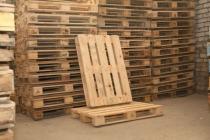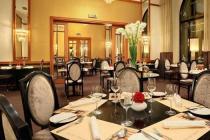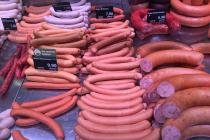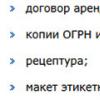The state decided to help the unemployed registered at the Labor Exchange. Gives them free of charge 58,800 rubles, or even more, “seed capital”, if they provide some formal business plan based on the idea of their business.
Most often, the thought comes to the mind of such novice businessmen: I will start trading in the market (in the sense, in the bazaar). Of course, before that, a person dealt with the markets only as a buyer. A novice entrepreneur walks around the markets, looks closely, asks traders, negotiates with the administration about renting a place. The idea to trade in the market is increasingly fixed in my head and, finally, is embodied.
At the same time, most newcomers to the marketplace make 10 typical “strategic” mistakes and go bankrupt. Most, but not all. Approximately 1-2 out of ten successfully trade. Too bad, everyone could.
First mistake: you look at what the traders already working there are trading on the market, how they are trading, what is being sold more successfully and you want to be equal to them, trade the same and the same.
From an increase in the number of merchants, for example, sausage, the number of buyers of sausage and money in their pockets will not increase. You have a balance between the number of outlets for specific products and the buyer flow of the market. You will just sit on the same customer stream, "biting off" a share of the proceeds of the old merchants.
You will not receive your share, because you have not yet “overgrown” with enough regular customers. As a result, you will not even have enough from the proceeds to pay for the rent of a trading place. Moreover, the old merchants will play dirty tricks.
It is necessary: to trade not in what is already being traded, but in what is missing in this market for buyers who regularly come here. To do this, ask buyers, observe and think, think.
Three attractive stereotypes in relation to retail markets (bazaars):
- you can find everything here
- here you can safely bargain (discount immediately)
- here for each product there is a "own" seller who can be trusted
And in this “find all” there may be voids. Look for them. But remember: if something is not on the market, this does not mean that it should be traded immediately. Perhaps the old sellers tried it - it didn’t work. Feeling a promising void in the assortment, carefully find out if they have already tried to trade this here?
And one more thing: do you want to be “like everyone else”, becoming part of the “common pattern”, or stand out, be different from everyone? Guess from 2 times: who will pay more attention to buyers?
Second mistake: you want to trade in what you yourself like: “I want to trade in elite teas, sweets, cookies - it's so beautiful! My layout (range) will be better than those of these merchants.
Trading what you personally like is like death. It is necessary to trade in what the market visitors like. In this case, see the "First mistake".
Third Mistake: You want to trade something that you think is not on the market, or very little represented.
The decision should be based on the opinion of the buyers, not yours. To do this, you need to study the buyer, learn, observe him (see "The first mistake"). The desires of buyers may not be to your liking. What do you want: income or satisfaction of your opinion?
Fourth mistake: you do not adequately evaluate the features of the location of the trading place that you were offered for rent in the market.
There are places "through": usually closer to the entrances, on the central aisles; and "impassable": in the side aisles, along the periphery of the market, in dead-end aisles. Places can also be impassable along the central aisles, but at the end of the trading row. Buyers are no longer available. Passing places are always busy. You, a beginner, will be offered only impassable ones.
Everyday goods (gastronomy, bread, cigarettes, for example) or “impulse demand” (household items, stationery, etc.) cannot be traded in impassable places. But it is possible to trade, and successfully, goods of "special" demand and a narrow assortment. For example, “only hunting knives”, or “everything for dog breeders”, etc.
But remember that in order to form the primary flow of "specialized" customers to your "specialized" place, you will need additional advertising already on the streams: a wall poster, a "clamshell", etc., but it's better not to be lazy and distribute simple leaflets at the entrances with advertising for a week your product and location. There is a plus: impassable places have low rents.
Fifth Mistake: You start trading without doing deep and detailed calculations of fixed costs.
Fixed costs are not just rent for a trading space. There is a lot more: a fee for various market services - the use of a cart, or permission to enter your car for unloading; payment to the veterinary laboratory, for the rental of commercial equipment.
Do not forget about the imputed tax once a quarter. So a decent amount is collected on trifles. Plus fines if payment is late for something.
Fixed costs do not depend on the level of your revenue. Even if you didn't sell it, pay it. Will your first month's income be enough?
Sixth mistake: you are guided by optimistic (and even rosy) forecasts for revenue and turnover.
Having polled, or somehow found out the level of revenue and turnover of traders already working on the market, you plan for yourself the same or even higher. Because you think you will be a better trader (see "Mistake Two").
Always consider "pessimistic" projections when planning any business when calculating revenue, turnover, and fixed cost levels. In most cases, in the first three months (place promotion, acclimatization) the net profit is zero. You have to pay fixed costs.
Have a reserve of primary capital in this case. Persistent traders sometimes take other jobs (in the evenings, weekends) to pay fixed costs from their salary while the place in the market is untwisted. And they do it right.
Seventh mistake: you do not adequately assess the cyclical nature of trading to start your business.
For any product during the year there is a cyclicity in trade turnover (by demand). In some months, very high revenues, in others, on the contrary, even a loss. It is necessary to focus not on income per month, but on the basis of the year. For some types of trade, 2-3 months "feed the whole year."
For example, fresh flowers. Experienced traders set aside a portion of the earnings of the "good months" to pay for fixed costs during the "bad months". As you plan your trading, carefully learn about the cyclicality of this commodity.
As a rule, opening trade at the end of spring at the beginning of summer is not profitable. But at this time it is easier to get a good (passing) place in the market and endure it with low trading until the revival in autumn. To give up in the hope of getting a “good” place in the fall is useless for a beginner.
Eighth mistake: you are a beginner, for the first time you open your trading place on the market, but you do not trade yourself, but hire a seller.
It is also like death. First, you will never learn to understand the intricacies of bazaar trading. Secondly, a hired seller is poorly motivated to "catch buyers" when promoting a new place, and generally keep a smile on his face.
The percentage that you promised him does not mean anything if the seller simply does not have the ability to promote the trading place. And sellers with abilities have long been attached. Thirdly, there is a whole business: to be hired by such newcomers in order to decently plunder and disappear.
The ninth mistake: you do not calculate the amount of working capital required, taking into account the "Parete's law".
Do you know such a law? Paret's law says: of all your products, only 20% of the assortment will bring the main (80%) revenue. The remaining 80% of the assortment provide only 20% of the revenue and can be sold for a very long time. But there is a paradox: without this allegedly unnecessary "ballast" in the form of 80% of the assortment, profitable 20% of the assortment will not be sold. abstruse?
Read thoughtfully several times. Experienced merchants explain this simply: in order to successfully trade, for example, only potatoes, you also need to put a wide range of all sorts of other things on the counter, up to nuts and bottled juice. But only one potato is not traded.
So, enough working capital is needed to buy both the main product and “for the assortment”.
Tenth Mistake: You start a trading business alone.
Without the support and participation of your entire family, or at least one person who loves you, you will not be able to cope. This is the main reason for successful work in the markets for traders of "other nationalities" - the participation of the whole family, from small children to distant relatives.
This is the real business plan.
If you find solutions to avoid making the listed mistakes in your specific case, then these solutions will be a true business plan for you. It would be nice to write down these decisions (how not to make mistakes) and constantly look into the records, correct, supplement. And then you will succeed.
Among the food products that are in the greatest demand among Russians, meat products occupy the fourth place, behind dairy products, vegetables and fruits, as well as bakery products. The demand for products is constantly growing. The consumer is becoming an increasingly powerful force in the domestic market. It is the consumer who dictates the rules in the market, determining the assortment and prices. Meanwhile, he is still not experienced enough, vaguely navigating the unusual variety of varieties and species, does not have pronounced preferences.
In particular, this is clearly manifested in the market of sausages and deli meats, which is very dynamic. It is characterized by a higher level of competition than other food markets.
Sausage producers are forced to work in conditions associated with constant risk. On the one hand, the market for sausages and meat delicacies is very dependent on the supply of meat raw materials, and on the other hand, the characteristics of a meat product as a perishable product leave a certain imprint on the nature of its implementation in terms of consumption. The sale of meat products is territorially limited by the place of production and the regions adjacent to it. The exceptions are large Moscow companies that have a powerful distribution system, such as Campomos, APK Cherkizovsky, Ostankino Meat Processing Plant, Tsaritsyno, Tagansky Meat Processing Plant, Dymovskoe Sausage Production, Velcom, " Sausage plant "Bogatyr" They provide 80% of the sausage market in Moscow. They are key players.
Traditionally, the most consumed are boiled and smoked sausages, sausages, sausages. Sausage can be considered a kind of barometer of the well-being of the population. In times of stability and improvement of the economic situation, the consumption of sausages increases, the situation in Russia worsens - the demand for sausages decreases. Over the years of the existence of domestic sausage production, a certain culture of consumption of sausages by the population has developed.
“My friends and I are going to the country on the weekend. So we decided to fry sausages and sausages. Very tasty at the stake. For nature - barbecue, for the holiday - meat delicacies, for every day - boiled sausage and sausages. All high quality and relatively inexpensive. Fast, tasty, satisfying, inexpensive. That's what you hear from domestic consumers in most cases.
In the overall structure of meat consumption, the share of sausages, incl. gourmet products in Moscow account for 40%. Of these, 33% accounted for the consumption of boiled sausages and 30% for the consumption of sausages and sausages. The consumption of meat delicacies accounts for 7-13%. At the same time, with the growth of incomes of the population, the demand for the consumption of meat delicacies increases. Delicacies begin to be consumed not only on the occasion of the holiday, but also from time to time, when "you want something tasty."
The tastes of the consumer over time become selective and they have to be taken into account not only in the near future, but also in the future. Gone are the days when a consumer could be pushed away by any product.
As incomes rise and living standards rise, the demand for deli products increases. However, the consumer always has to make a choice, because there are a large number of different brands and types of delicacies on the market. "Whom to choose? What to prefer? What's delicious?" In the premium segment, the quality of the products offered is of great importance. The price when choosing fades into the background.
How to win over the consumer of the premium segment, especially when the main activity is mass-market products?
In recent years, domestic producers of meat products began to use the experience of competitors from abroad and began to pay more attention to the design of their products. A colorful shell began to be used, which made it possible to increase the shelf life, piece products (produced in standard weights) became widespread. This makes domestic products more competitive.
The volume of the Russian market for products of the meat processing industry in physical terms reaches about 1.65 million tons per year. The ratio of products of different price niches annually changes towards an increase in expensive products. Meat/sausage products of the expensive segment account for about 20% and its share annually increases by 2-3%. It would seem that the situation in the country is changing, economic well-being is changing towards improvement.
Demand for deli products is increasing, but still a certain culture of consumption of delicacies has not yet developed, and the consumer cannot prioritize among the main producers, he is lost in the abundance of products offered to him.
In order to successfully compete in the market of meat delicacies, the manufacturer must take into account the peculiarities of the market:
- The market has reached saturation. The rules of the game are dictated by the conditions of fierce competition, according to which the assortment, quality and pricing policy are determined.
- Branding is under development. However, most of the activities for the development of the enterprise, the creation of brands occur spontaneously.
- The excess of sausage products in retail outlets orients the manufacturer towards the production of high-quality branded products, the search for new niches and the creation of innovative products.
- One of the main requirements for the product is quality stability.
- The market is occupied by a small number of key players that serve 80% of the needs of the entire sausage/deli market.
- Market segments are shrinking.
Nutrition trends:
- Quality is everything.
- Healthy food boom.
- There can be no differentiating idea in a sausage.
Replicable distribution strategies:
- Influence on the final element of distribution - sellers. A special case is the replacement of sellers with "our own" ones, who are interested in selling the products of this particular plant.
- Rumors and word of mouth.
At the heart of gourmet food trends, quality is everything. The consumer is looking for the highest quality products, without thinking about the price. In the production of premium class products, special attention is paid to the quality of these products. Quality is the primary feature of a premium brand. To guarantee the constancy of quality is the main task of manufacturers, since it is the constancy of quality that carries a premium brand.
A premium brand naturally attracts consumers - innovators and opinion leaders, thanks to which verbal communications arise about it (mention that in marketing research more than 50% received information from acquaintances and the remaining 50% from various media. Despite abundant advertising).
Premium brands can use highly targeted codes to create the richest, most seductive looks and experiences.
Turning a brand that was originally aimed at the mass market into a brand with a premium status is almost impossible. In this regard, many companies do not push their luck and instead of trying to enter the premium sector organically, they create a separate premium brand. A good example is Toyota and its premium brand, Lexus.
Thus, it is problematic for large companies producing meat delicacies for the mass market to produce high-demand premium meat delicacies. Since in Russian practice in the market of the meat processing industry, the name of the product is assigned based on the manufacturer's plant.
It is also difficult for large meat processing plants to keep the western bar of quality.
Until recently, the question of whether it is necessary to promote meat products using BTL methods (promotions, merchandising) simply did not arise - meat already belongs to essential goods. With the growth of competition, the situation has changed.
“The volume of sales after promotions increases by 40%,” says the expert of APK Cherkizovsky. The specificity of the meat market is that numerous producers offer consumers products with the same names, the range of large factories exceeds 300 items. In such conditions, it is very important to differentiate your product in the market. The decisive factor in the choice of meat products for the consumer with equal prices are taste and appearance. With an abundance of offers of similar products, the most effective method of promotion is merchandising and promotions (tastings and rewards for the purchase). The specifics of promotion are dictated by the product itself, or rather its consumer properties: freshness, appearance (cut). In order for the consumer to appreciate the quality and taste of products and spend a minimum of effort to find them in a retail outlet, it is necessary to highlight the desired product with POS materials, branded commercial equipment and maintain uniform display standards. A strong tool for promoting meat products is working with sellers, as 43% of male buyers ask sellers for advice on product quality.
In conditions of fierce competition and market saturation, manufacturers use different forms of advertising support. Small and medium-sized producers prefer promotion at the point of sale, larger ones - advertising on TV. For example, the marketing budget of Campomos in 2005 amounted to about $6 million, with television advertising accounting for half of this budget, 30% for BTL events, which, according to experts, make it possible to more effectively convey product ideas to the consumer, form positive image of the company. In addition, manufacturers use print media to advertise their products. Manufacturers agree that it makes no sense to promote high-end products through mass TV advertising. The emphasis should be on points of sale where the customer is closest to the advertised product, relevant POS materials and, possibly, glossy magazines. The choice of a specific promotion channel or a combination of them depends on a comprehensive strategy for bringing a product or brand to the market.
In the domestic market of sausages and deli meats, the most interesting promotion strategies are demonstrated by the largest players. So, the company "Dymov" for a relatively short period of time managed to take a stable position in the market. Despite the stereotypical behavior of residents of million-plus cities who consume sausages, frankfurters and sausages, nevertheless, with an increase in income, the consumption of deli products also increases slightly, especially if we take into account the factor that delicacies belong to the category of healthy food .
And why not promote your products here? Since the peculiarity of the market of sausages and deli meats is that the majority of manufacturers have concentrated their production in the middle segment, the deli niche is still unfilled. And the market continues to grow and new competitors appear. The Dymov company, which has focused its efforts in the above-average segment as the most attractive in terms of the marketing tasks set, has developed a special line of Haute Cuisine products - meat products with a unique filler: oregano, saffron, red wine, etc. Main idea: "Dymov" is a product for people who choose high quality, exclusivity and prestige. To conduct an advertising campaign, unique recipes for meat products included in the line were developed, label design and a non-standard outer casing of sausages communicate premium and high quality products. The main goal: to convey to the consumer the idea that the meat products offered by the Dymov company can be a true masterpiece of table decoration.
An unusual promo stand was installed in the trading floors of Moscow supermarkets. Promoters handed out flyers announcing the promotion to visitors, and also invited them to taste products from the Haute Cuisine premium line. The promoters offered to try meat delicacies from the Dymov company, told in detail about each of the positions presented at this tasting, and informed buyers about the prize scheme. For the purchase of products from the Haute Cuisine line, the consumer received a gift - an original magnet, a gift set of candles or a frame for a photograph (depending on the purchase amount). The action was successful. The volume of sales of Dymov products of the Haute Cuisine line increased by an average of 3-4 times compared to the usual period. It was possible to increase the interest of the target audience in premium products, strengthen the image of the Dymov company and interest in the brand.
When the Dymov brand became quite well-known in the Moscow market, the main task of the company was to convey information to consumers about the unique taste of products, so the press, POS-materials, promotions, sponsorship and special events were chosen as the main channels to reach the target audience. can get full information "why he should choose "Dymov" and evaluate the quality of products through tasting at the place of purchase. The brand was accompanied by interviews and commentary by Vadim Dymov in many mainstream, business and consumer publications.
The result of a properly developed and implemented creative and media strategy was the following results: the Dymov company ensured its presence in all major retail chains in the high price segment, expanded distribution channels, including in the regions; the successful launch of a new line of sausages "High Cuisine"; there was an increase in sales: in the period from September 2004 to September 2005 in Russia as a whole amounted to about 70%.
Currently, the Dymov company pays great attention to the display of goods on store shelves, while trying to adhere to the main rule of merchandising: it must be the result of a joint effort of the manufacturer, distributor and seller, and the needs of the buyer should be at the forefront. An interesting display of meat products is an important condition for high sales. On the showcase, products are laid out in three ways: the first - by manufacturers, the second - by categories, the third - by names. Shelving is also carried out: horizontal and vertical. In order to attract additional consumer attention to products in general and increase daily turnover due to additional opportunities for impulse purchases, Dymov, for example, uses additional points of sale - special refrigerators. Products in them are facing the buyer, and the most popular products are laid out on priority shelves.
Campomos positions itself as a company that offers consumers innovative solutions, such as completely new flavors, as well as unexpected packaging solutions for already familiar and beloved products. Today, it is this brand that is able to surprise the consumer, meeting the expectations of originality and innovation, while also protecting traditions and values.
In network retail, suppliers hold special events to promote meat products. So, in the Paterson network, suppliers conduct extended tastings of new products with original display on the display window, provide a branded stand for products, place interesting and beneficial product offers for the buyer in booklets produced by the chains, conduct consultations for buyers that stimulate the initial purchase and support demand. for premium products.
So, according to the experience of major market players, whose activities have been successful in the effective promotion of gourmet products, the following events can be distinguished - these are media channels, which include television, radio, points of sale, on-line, the press (the company "Dymov" is the first of the manufacturers meat products appeared on the pages of glossy publications - Cosmopolitan, Shape, "She", etc.; the company constantly works with the media), direct marketing, Sales Promotion (BTL programs, tastings), public relations (organization of conferences and presentations for partners, etc.), outdoor advertising, participation in exhibitions, special events, sponsorship. Experts unanimously assure that today it is inefficient to use mass advertising channels to promote delicacies, and the main attention should be focused on points of sale, on the development and distribution of POS materials, as well as work with glossy magazines.
It can be predicted that the redistribution of consumer preferences by manufacturer and consumer commitment to new types of meat and sausage products will occur due to active marketing activities and extraordinary technological solutions.
I want to offer a "rejection" option, this is a tough way to sell. It can be used provided:
1. The need for the product is 100% identified. The product is needed, and needed now, the offer is profitable.
2. The seller knows exactly the reason for the refusal.
3. A potential client needs to be squeezed.
4. The seller has experience in sales.
Example:
My very good friend, young in age and experience in sales, recently got a job in a sausage company.
For the first week of work, she had to find at least three clients, conclude an agreement and make a shipment.
She started working on Monday. Came to me for help on Thursday in a snotty mood, because she could not arrange a shipment with any client.
I had to leave the city, and I could devote no more than three hours to her.
1. I gave her 30 minutes to tell me about the pros and cons of the product, price segment, competitors and working conditions, etc.
2. We went to 2 stores at once, next to my house. Luckily for us, the directors were there. I am a sociable person and all the janitors, children, their mothers, shop assistants, directors, as well as cats and dogs in our yard know and love me...
We made an order after a smile and the words: Hello, there is meat sausage, at an affordable price, you need to place an order today. First there was a pause, then laughter, sellers, directors, buyers and we laughed.
Then there was the question: do we need it?
My answer: Yes, it is very profitable for you!!!
Again laughter and a question: Tanya, how do you know what is beneficial for us?
My answer: The stars told me!!!
Again laughter and the question: Is it possible tomorrow?
My answer is no!!!
Question: Why?
My answer: Tomorrow the chip will not fall!!!
again laughter and: Come on, bring your sausage. Faya replace Lena, she makes an order. Lena surprised: I'm not doing anything yet! Again, loud laughter from all those present and the headmistress: You are doing it, Lena, you are already doing it!!!
3. Let's go to the third store. Here the method of hard rejection was used.
I rarely go to this store, a very small assortment, the only advantage is the presence of a department of household chemicals. I don't know the director.
We go in, smile, find out from the seller who is in charge of the sausage, she calls the headmistress.
A woman of 120 kg comes out, with an expression on her face: Why are you stuck? Well?
Ignoring her expression, smiling for 1 minute, I say who we are and why we came. Reference: On a large showcase they had 10 lone sausages.
The director (Irina Aleksandrovna) after listening (with a sour face):
Leave the price and booklet. I'll take a look and if I'm interested, I'll call you.
I understand: Our client!!! And we can’t avoid tough communication and we won’t leave without an order !!!
I say without a smile, but kindly: How can you call us if you don't know our phone number?
Irina Alexandrovna after a pause and with surprise: Why don't you leave it to me, and why isn't it in the price list?
I, without a smile with a harsh note in my voice: No, it is not in the price list, and we will not leave it to you, you do not need it. And without waiting for her answer: Irina Alexandrovna you also don’t need a booklet with a price list, unless you want to use the booklet as wallpaper and the price list as paper will be useful to you for household purposes. I stop and watch her eyes fill with blood, waiting for the explosion:
Irina Aleksandrovna explodes: Did someone call you here??? Who even told you that I need your phone? Etc. within 2 min. harsh words...
I calmly listen, look into her eyes. After her first explosion, there is a pause.
I told her in a calm voice: Irina Alexandrovna, you are absolutely right, they did not call us and you do not need our telephone.
I have a hard note in my voice, without waiting for her answer: I know what you need!!!
I look into your eyes and say harshly: There are 6 multi-storey buildings on this heel. For 6 houses 3 grocery stores. Department with household chemicals only for you. People come to you not for food, but for powders! Do you know that in one of them one of the utility rooms was removed and a department is being made? Do you know what department this is? Right! Household chemicals! And how many showcases are allocated in these stores for sausages? 2 showcases! 30 kg of sausages for each minimum! Now look at your shop window and the lone riders in it.
You need to lose your customers within the next month! That's what you need!
Yes?
I quickly take my price list, write my cell phone and say: Irina Aleksandrovna, if I am mistaken and you do not need this, I will be glad to hear from you. Together we will attract new customers and increase your profits!!! Sausage is eaten well here! You can verify this tomorrow. All the best!!!
I smile and we leave.
My friend, moving away from the store, says: Her face has become like a bucket!!! Have we lost her? Don't visit her again?
Me: Let's go, in 10 minutes!
My friend, with surprise: Why???
Me: For an order, let her imagine for now how everyone left her +++
In ten minutes we go in, please call her.
Irina Alexandrovna comes out, tiredness and devastation on her face ...
Me with a smile: Irina Alexandrovna, you will be surprised, but we already miss you!!!
She with a slight smile: Why did they come to drink the rest of the blood ???
We laugh and she starts laughing.
Me: Don't be offended by me, I couldn't resist. But there is a plus. You will get good sales for sausage yourself, then you will say that maybe it was not in vain that we quarreled with you like that.
She laughs: I don’t know about the profit, but I’ll definitely earn a heart attack with you!
I laugh: Irina Alexandrovna, could you give us a booklet? He is the last one we have today. You are still thinking. And we would still work with him today.
After a pause, she leaves for the booklet. He comes back and says with slight resentment:
It is inconvenient to place an order without a booklet, I have already started looking.
Me without pause: I see, you only have a little, for the first time?
Without waiting for her answer and without looking at her, I take out the order form and start filling it out.
She is anxious in her voice: I still have no money today.
Me: You don’t need it today, give it back tomorrow after receiving it.
Today it will not be possible to bring you sausage. In the shipping department, every sausage from your order will be wrapped in a festive ribbon all night long!!!
Me: Milk sausages 3 or 5 kg?
Irina Alexandrovna: For the first time, let's 3kg+
Food trade has been and remains a popular segment of goods among buyers, even in times of crisis. Recently, specialized, narrowly focused food stores have become especially popular, in particular, today we will talk about one of these, namely, how to open a sausage store and what to focus on when promoting it in your city.
Business Features
As with any food, selling them has both pros and cons. In particular, the high demand for sausage products among the population makes this business very attractive. But at the same time, the goods are perishable, and accordingly, there are some risks of receiving unsold products that will need to be written off. These points can be attributed to almost any type of product.
What about competition? She is really tall. In almost every grocery store you can see a showcase with sausages, but at the same time, branded sausage stores from a particular manufacturer are becoming very popular on the market. Often they also work very successfully in the market and develop a base of regular customers due to the quality of products and the range of meat products. Alternatively, you can fill this niche and become a representative of some sausage factory in your city.
The second option is to work with many manufacturers, and focus on the vastness of the range and the freshness of all products.
The third option is selling sausages on the market. A kiosk with refrigeration equipment is rented. True, usually in this format of activity there is high competition, but if the assortment allows, and you know how to improve the service or win at a price, then you can safely start.
Sausage trade rules
As with any product, selling sausage requires a series of permits. Let's look at them in more detail.
What documents are needed for selling sausages:
- you must have an individual entrepreneur and indicate all the necessary OKVED
- you must have all the permits regarding the retail space that you will rent. These are permits from the SES and from the fire service.
- all goods must be confirmed by quality certificates
- a buyer's corner should be organized
Selection of premises and equipment for trade
The best place to sell sausages are outlets in crowded places, such as near food markets or adjacent grocery stores. The size of the retail space should be looked for in the region of 30 sq.m. and more. It is this size of the room that will allow you to properly arrange all the showcases with products.
From the trading equipment you will need:
- refrigerated showcases, for demonstrating sausages
- racks and cabinets
- organization of the workplace for the seller
- sausage cutting machine Mandatory equipment in this business.
- cleaning products
- cash machine
Perhaps, if the assortment is large, additional freezers will be needed to store sausages and meat products.
Range
The sausage business is not limited to these products, there is a whole list of products that complement the assortment of such a store.

Here is a list of product groups:
- boiled sausages
- sausages, sardines
- smoked or fried sausages
- delicacies
- meat snacks
- grill menu
- kebabs
- smoked and baked meat and bacon and more.
The assortment can be wider, and all these products can be from different manufacturers, which allows you to offer the customer a wide selection of sausages in your store.
Advertising
To promote such an outlet, you will first need to apply local advertising, namely:
- distributing leaflets near the store
- banners with promotions and discounts
- a bright sign or the design of the store itself.
For the best promotion of a sausage shop, you need to carefully select an area for trading in a crowded place, this will be your main advertisement.
Business on homemade sausage and smoked meats
 A separate area can be identified as a line of business when you yourself organize the production of homemade sausages, or rather, launch a small workshop. In fact, the price in the end, if you do everything qualitatively, turns out to be higher than products from large manufacturers and your competitive advantage is the quality and naturalness of sausages.
A separate area can be identified as a line of business when you yourself organize the production of homemade sausages, or rather, launch a small workshop. In fact, the price in the end, if you do everything qualitatively, turns out to be higher than products from large manufacturers and your competitive advantage is the quality and naturalness of sausages.
Consider an important point in order to open a homemade sausage trade in the market, you will need product certificates. You can find out how to get them by consulting a lawyer.
As a business, this is a good direction, but it is very specific and for a beginner in this area, most likely it will not work. To market such products in the future, it will be necessary to establish cooperation with other grocery stores.
What start-up capital is needed?
Depending on the format of work, the initial investment in the sausage trade business can vary significantly. We will give only a basic list of costs for starting this business.
- Premises rent – $300 – $350
- Taxes - $150
- Salary to the seller - $ 200
- Initial purchase of goods - $5000 - $7000
- Purchase of equipment - $2500 - $3000
- Advertising - $200
What income can you expect?
In fact, everything will depend on competition, assortment, service, sausage quality and product freshness.
The average markup on sausages is 20% - 40%.
Conclusions. Opening a specialized sausage store is quite realistic and quite profitable, but at the same time, due to great competition, you will need to look for ways to improve your outlet relative to competitors, perhaps it will be an assortment or a lower price.
Do you have anything to add to this business idea? We are waiting for your comments.
A small meat business is a fairly profitable business with a fairly small initial capital. If you are going to open a small butcher shop, for example, in one of the markets in your city, then the most important thing here that can lead to the death of your business is your seller. It’s good if you yourself or someone close to you is behind the counter and values each client. And if not, there is some kind of aunt who is with you today, and tomorrow in front of you, she trades, and behind these aunts you need an eye, yes an eye!
Business plan:
Analysis of the meat market showed:
- A relatively small amount of initial investment is required to enter the market;
- The ability to quickly enter into the direct conduct of business
- Fast payback
Business Feature:
Pricing system - average market;
- System of discounts - as the business moves forward in a highly competitive environment, discounts must be avoided. At the initial stage, there is a lack of financial resources, and there is no accumulated client base to maintain a system of discounts; competitors in the market, having both resources and a customer base, will quickly crush the business at the root;
- Comparative analysis of prices - in the meat sales market and in conditions of fierce competition, prices are basically the same;
- Organization of sales of products - through a point of sale in the market, in the future - through several outlets and markets;
- Promotion system - advertising, in the form of stickers on packages, with products;
- Growth strategy - expansion of activities, opening of new outlets in other areas
- Potential consumers - since the place of doing business is the city market, the consumer is anyone living in the city of Yelizovo or the Yelizovsky district; for example - buyers living nearby; random shoppers whose way home or to work passes by the market; non-random buyer, specifically going to the outlet
- Market segments - no clearly defined segmentation
- The number of clients - on weekdays (on average) from 15 to 30, on weekends and holidays from 30 to 70 and more;
- Motivation for purchases - high-quality and fresh products for people of any income;
- The degree of satisfaction of needs - a high degree, due to a wide range;
- Market capacity - the share occupied in the market at the initial stage will be about 4-6%;
- Character of demand - constant;
- Characteristics of competitors - individual entrepreneurs;
- Difficulties in entering the market - a lot of competitors, no established customer base, lack of money.
Point of sale setup costs
Bonetta (refrigerator-showcase, already installed) - 80,000 rubles.
- Freezer - 25,000 rubles.
- Scales - 5000 rubles.
- Packing bags, knives, stickers (monthly consumption) - 2000 rubles.
Download the Business Plan for a butcher shop in full, you can follow the link
The range of manufactured products - smoked and boiled sausage in an artificial casing, smoked meat of various types.
Technology production involves the use of special recipes developed by specialists from SHALLER, a world-famous manufacturer of top quality meat processing equipment.
Operating production facilities a pig farm and a poultry farm make it possible to provide a raw material base for the projected meat processing complex. Annual production consumption of raw materials (meat) - 1.8 thousand tons.
Planned volume output of finished products - 1.5 thousand tons in the amount of - 25.11 million rubles. on the basis of existing production facilities and their reconstruction.
sales market products are wholesalers and retailers, public catering establishments in Novosibirsk, the Novosibirsk region, as well as the company's own distribution network.
total cost project for the commissioning of a meat processing plant 3.13 million rubles, which are planned to be attracted from outside.
Firm staff It is staffed with highly qualified specialists engaged in growing crops, processing agricultural products and selling them. The total number of personnel is 400 people.
Competitiveness the company is provided with low internal production costs due to the organization of the company's production in a closed technological cycle - from self-cultivation of feed and grain to processing and
sales of agricultural products through its own trading network.
Payback period credit funds for the projected meat processing complex - less than two years.
Download Meat Processing Business Plan -
“Despite the abundance of sausages and delicacies from large manufacturers, such as Parnassus, Kronstadt Meat Processing Plant, Sagittarius and many others, beginning meat processors have every chance to succeed in the market,” says Ilya Nevodnik, Commercial Director the Torgovy Mir company, which supplies equipment for food production and trade and service industries. In his opinion, the consumer appreciates original recipes and the "homemade" taste of sausages, which distinguishes the products of small industries. “In addition, customers get tired of the monotony of brands in stores, and small-scale products are not found in every point. Trade enterprises that sell it are in a winning position, because they offer the buyer an "exclusive". If the business is properly organized, a meat processing plant that produces 1 ton of products per shift pays off in 4-6 months, and the profitability of such production is up to 30%.
Small sausage enterprises are in an advantageous position, because they offer the buyer an "exclusive". If the business is properly organized, the meat processing workshop pays off in 4-6 months, and the profitability of such production is up to 30%.
The fashion includes "sausage exclusive". According to experts, a meat processing plant for the production of boiled and boiled-smoked sausages, frankfurters and sausages, meat delicacies and additional meat products can become a profitable enterprise and make a profit if its productivity is from 1 thousand tons of products per shift.
You can download a small business plan for processing meat into sausage from our VKontakte group -
In order to open a butcher shop, a counter is enough, which can be rented at a grocery store. The area you need will take about 6 sq.m.
The equipment for your point of sale should look respectable and be affordable. Trust foreign manufacturers or domestic - decide for yourself.
So to open a butcher shop you need to purchase:
1. Freezer counter (average cost 2,000 USD)
2. Cash register (90 USD)
3. Electric meat grinder (460 USD)
4. Set of knives
5. Ax
You will also need overalls for butchers. For convenience, a sink can be equipped next to the counter. A beautiful sign above the counter will serve both advertising and aesthetic purposes. In total, all your expenses will not exceed 3,000 USD.
Your main goal is to secure a trademark for your firm. This can be done only by trading in high-quality and fresh meat. Of course, it is more convenient to work with permanent suppliers. But even they should not be trusted 100%. Remember that trading in low-quality raw materials is subject to criminal liability. Therefore, always save invoices-certificates that you receive from suppliers, check the hallmarks.
Own business - Butcher shop -














